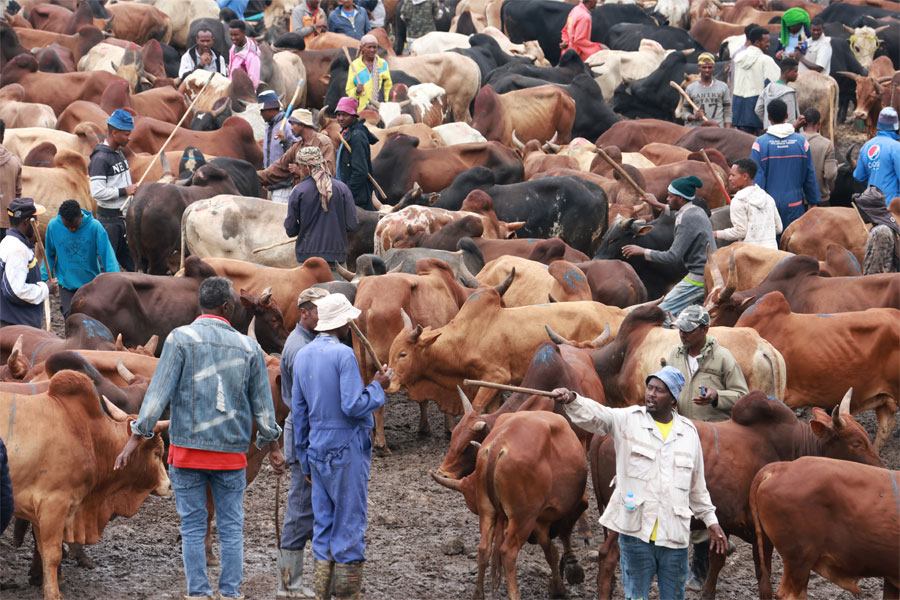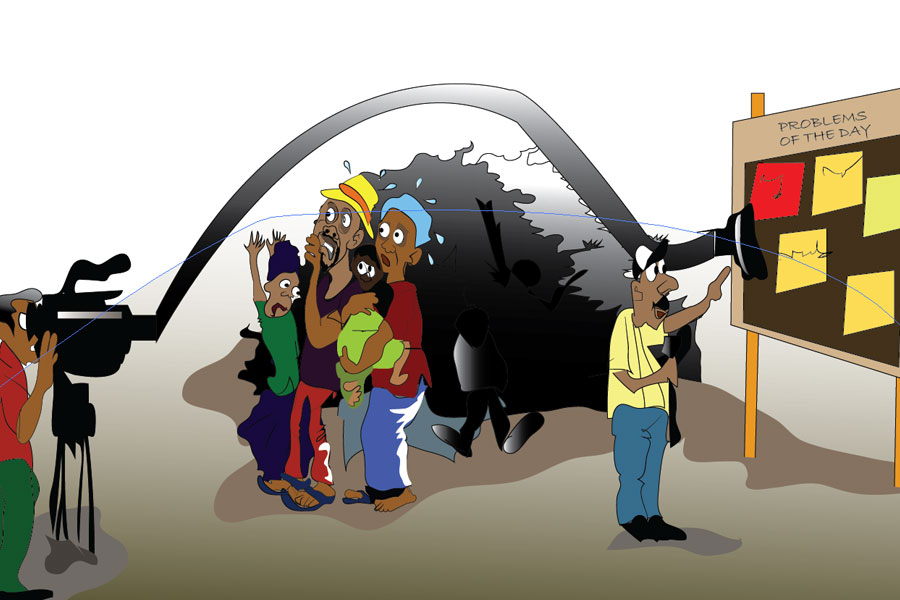
Agenda | Sep 28,2024
Aug 5 , 2023
By Mario I. Blejer , Piroska Nagy Mohácsi
The world economy is not out of the woods yet. While recent figures have been encouraging, bringing down inflation is just one part of the post-COVID-19 recovery process. It is still unclear whether these trends will persist, write Mario I. Blejer, a former director of the Centre for Central Banking Studies at the Bank of England, and Piroska Nagy Mohácsi, a visiting professor at the London School of Economics & Political Science, in this commentary provided by Project Syndicate (PS).
After more than a year of aggressive monetary tightening, inflation in the United States and worldwide is finally trending down. Cautious celebration is in order: monetary policy can be effective, and central banks, after abandoning the fiction of “transitory” inflation, have retained enough credibility to respond effectively.
Contrary to the projections of standard macroeconomic models, and despite the US Federal Reserve raising its policy rate to a 22-year high, the ongoing disinflationary process has not triggered significant output losses or massive unemployment. Apart from some self-inflicted policy mistakes that caused several US banks to fail, disinflation has been relatively painless thus far.
Moreover, emerging markets have taken the lead in fighting inflation, initiating monetary policy tightening almost a year before the Fed and other major central banks did, and they have successfully avoided the financial stresses that have plagued them during the Fed’s previous tightening cycles. But the world economy is not out of the woods yet. While recent figures have been encouraging, bringing down inflation is just one part of the post-COVID-19 recovery process, and it is still unclear whether these trends will persist.
What is certain is that ignoring the historical context of economic developments is a recipe for policy mistakes.
Contrary to popular belief, the roots of today’s inflation crisis run deeper than the COVID-19 crisis. While the spike in inflation and subsequent interest-rate hikes are frequently attributed to excess demand triggered by the fiscal and monetary response to the pandemic, these measures merely exacerbated imbalances created by the policy response to the global financial crisis (GFC) of 2008-10. Major central banks’ balance sheets have more than tripled since 2008, as a decade of quantitative easing (QE) led to strong monetary growth and spurred an unprecedented bond-buying spree. Even in emerging markets, central banks’ balance sheets expanded significantly during the pandemic.
While these ultra-expansionary monetary policies undoubtedly played a crucial role in mitigating the worst effects of the financial and COVID-19 crises, they also generated enormous macroeconomic imbalances, such as ballooning money supply and excess bank reserves. This, in turn, created massive risk-taking incentives, encouraged higher levels of public and private debt, inflated speculative asset bubbles, and skewed resource allocation toward short-term yields and away from real investments.
The direct and indirect bailouts that characterised the “whatever it takes” era have led to an enormous build-up of moral hazard.
Post-crisis financial reforms inadvertently encouraged regulatory arbitrage, paving the way for an exponential increase in the share of financial assets held by lightly regulated nonbank financial institutions such as hedge funds and crypto exchanges. These institutions account for roughly half of all financial assets, exacerbating systemic risks.
To be sure, the current bout of inflation was also driven by other factors, such as pandemic-related supply-chain disruptions, Russia’s full-scale attack on Ukraine, the escalating rivalry between the US and China, and the growing economic nationalism reflected in broad-based industrial policies. Central banks may have aggravated some of these issues by rapidly tightening their monetary policies to control inflation, triggering bank distress and potentially even a recession. The fact that they face significant challenges in unwinding their bloated balance sheets and addressing related perverse incentives further complicates matters.
Central banks missed the opportunity to embark on serious quantitative tightening in the post-financial crisis decade. Then, when Silicon Valley Bank collapsed in March and threatened to trigger a banking crisis, the Fed intervened by implementing a round of QE that effectively reversed two-thirds of the modest balance-sheet reduction it had previously initiated. The US government also stepped in and guaranteed all deposits in the affected banks, regardless of their status and size, setting a dangerous precedent for future bailouts.
Despite the overall monetary tightening in Europe, the European Central Bank has continued to conduct a sub-QE policy with the Transmission Protection Instrument, under which it purchases bonds from riskier eurozone sovereigns such as Italy.
While inflation’s downward trend and the containment of the incipient banking crisis provide some relief, the world’s major economies are still grappling with distorted incentives and massive inherited imbalances, some of which are still growing.
These factors are further compounded by strong political pressures for increased government involvement in the economy. In several advanced economies, the government’s response to the COVID-19 crisis, which included government transfers, subsidised handouts via the central bank, and many regulatory exemptions, has created a growing demand for broad government intervention and bigger government. While this is necessary in some areas, particularly when accelerating the green-energy transition through targeted industrial policies, addressing other essential problems, such as inequality or outdated infrastructure, should be carried out within existing government processes and budget constraints.
Governments’ growing involvement in the economy has also raised expectations of additional public support and bailouts, fueled by populist politicians from both the right and the left. Regardless of their political leanings, no government appears willing to accept even minor economic distress. The financial and COVID-19 crises have institutionalised bailouts that imply far-reaching moral hazard.
Crisis-resolution measures have increased concentration in the financial sector and elsewhere, such as the already concentrated tech industry. Moreover, the rapid proliferation of private currencies has challenged central banks’ monetary sovereignty, prompting them to develop their digital currencies. This will further increase central banks’ footprint in the financial sector.
This confluence of populist governments, economic nationalism, interventionist central banks, and oligopolistic markets could undermine the basic tenets of entrepreneurial capitalism and usher in a new era of state capitalism across the developed world. Given populist governments’ reluctance to raise taxes, deficit financing and related inflationary pressures are also likely to persist.
At a time of heightened risk-taking and macroeconomic and geopolitical uncertainty, any celebration of progress in combating inflation must be cautious. There is still a long road ahead.
PUBLISHED ON
Aug 05,2023 [ VOL
24 , NO
1214]

Agenda | Sep 28,2024

Fortune News | Jan 18,2020

Fortune News | Jul 18,2020

Viewpoints | Jun 18,2022

Agenda | Sep 09,2023

Covid-19 | Apr 01,2020

Agenda | Mar 11,2023

Viewpoints | Apr 19,2025

Commentaries | Feb 13,2021

Editorial | Jan 18,2019

My Opinion | 131499 Views | Aug 14,2021

My Opinion | 127855 Views | Aug 21,2021

My Opinion | 125833 Views | Sep 10,2021

My Opinion | 123463 Views | Aug 07,2021

Dec 22 , 2024 . By TIZITA SHEWAFERAW
Charged with transforming colossal state-owned enterprises into modern and competitiv...

Aug 18 , 2024 . By AKSAH ITALO
Although predictable Yonas Zerihun's job in the ride-hailing service is not immune to...

Jul 28 , 2024 . By TIZITA SHEWAFERAW
Unhabitual, perhaps too many, Samuel Gebreyohannes, 38, used to occasionally enjoy a couple of beers at breakfast. However, he recently swit...

Jul 13 , 2024 . By AKSAH ITALO
Investors who rely on tractors, trucks, and field vehicles for commuting, transporting commodities, and f...

Jun 28 , 2025
Meseret Damtie, the assertive auditor general, has never been shy about naming names...

Jun 21 , 2025
A well-worn adage says, “Budget is not destiny, but it is direction.” Examining t...

Jun 14 , 2025
Yet again, the Horn of Africa is bracing for trouble. A region already frayed by wars...

Jun 7 , 2025
Few promises shine brighter in Addis Abeba than the pledge of a roof for every family...

Jun 29 , 2025
Addis Abeba's first rains have coincided with a sweeping rise in private school tuition, prompting the city's education...

Jun 29 , 2025 . By BEZAWIT HULUAGER
Central Bank Governor Mamo Mihretu claimed a bold reconfiguration of monetary policy...

Jun 29 , 2025 . By BEZAWIT HULUAGER
The federal government is betting on a sweeping overhaul of the driver licensing regi...

Jun 29 , 2025 . By NAHOM AYELE
Gadaa Bank has listed 1.2 million shares on the Ethiopian Securities Exchange (ESX),...